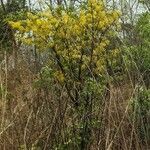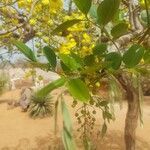A tree that loses its leaves during the dry season. It grows 10-20 m high. The bark is dark grey and wrinkled. The leaflet stalks are 20-30 cm long with 7-10 pairs of leaflets. They are 5-10 cm long by 3-5 cm wide. The flowers are bright yellow and attractive. They are in groups that can be upright or hanging. These groups are 30-50 cm long. The fruit is a long pods. It is dark brown and 40-80 cm long. It has division between the seeds.
Pendulous laburnum-like yellow flower-racemes, and black fruits; flowering in dry season, often when leafless
A tree, to 50 ft. high



